Wisconsin State Journal Death Spiral

The predecessor of the Wisconsin State Journal was founded in Madison in 1839 when Wisconsin was a rude territory, and as Whigs they endorsed William Henry Harrison in 1840 - Wikipedia has a great write-up on this paper over the years. The State Journal played a heroic role as anti-slavery crusaders in the Glover case in Milwaukee in 1854, helping to defy the Fugitive Slave Act and spring recaptured slave Joshua Glover from jail (I remember reading about it circa 1970 in Eric Foner's Free Soil, Free Labor, Free Men and feeling oddly proud of my hometown paper). Like many Whigs, including Abraham Lincoln, they became Republicans and duly endorsed the Great Emancipator. They became a progressive and even muckraking organ in the period 1890-1916. Since then they've been a reliable right ring mouthpiece, recent timid attempts to transcend that heritage notwithstanding. They were virulent jingoists in the First World War, scurrilously attacking Fighting Bob La Follette. They were shameful McCarthyites from the get-go, endorsing him in every one of his state-wide campaigns, including the first run for Senate in 1944, when they were one of four papers to do so and the only one outside the Appleton area. They broke their workers' strike in 1977 (I was on the board of the strikers' paper, the Press Connection).
This went on relentlessly for a hundred years, even as the community they claim to serve has veered to the left (Madison 75% Democratic in recent elections, Dane County 65%), a process in the making for fifty years and more. The Wisconsin State Journal is badly out of step with Madison, saddled by decades of right wing advocacy making it a bête noire to thousands even as it struggles to rise above that history in an increasingly challenging business, social, technological, and political environment. Endorsing Scott Walker in 2010 convinced many that they are a lost cause unworthy of resurrection. They fatuously touted Walker as "best for jobs", stunningly inept in light of Walker's willful job destroying record and indicative of a mindset clouded by a century of mindless reactionary cant. Money quote: "Walker is no extremist." No, not Scott, whose life's blood is chaos and who will move heaven and earth to create it when calm and good order prevail.
Devotedly Republican and right wing in the recent past, the State Journal surprised everyone by endorsing Obama in 2008. Maybe like everyone else they noticed what a miserable failure their boy George W Bush was (they endorsed him twice). More likely they read the polls and thought it was pointless to buck the headwind (Obama won Wisconsin by 13% in 2008). They reverted to form with Walker in 2010, then Tommy Thompson over Tammy Baldwin for Senate in 2012 and also reversed course to endorse Romney.
Just read the Romney editorial - like so many of their performances, it is a meretricious piece devoid of underlying logic, not even right wing principle, their standby in the past. "Not enough hope and too little change," they intone, looking to Romney for a bipartisan approach. As if the Republicans weren't doing everything to destroy Obama and forward a scorched earth approach. They seem intent to insult and defy the majority of people in their community, underscored by a lack of any real feeling or commitment other than a vague, atavistic memory that reaction is part of their DNA. I'd compare them to the House of Lords in 1910 before being neutered, except those old reprobates actually believed in something. These champions (and massive institutional beneficiaries) of the First Amendment now feel free to dictate political behavior to their now non-union and unprotected employees, publicly castigating a number of non-editorial workers for signing the recall of a candidate they endorsed.
its worst, the State Journal takes an authoritarian approach you would think journalists find repugnant. Such was the case when Scott Milfred wrote a column in November 2006 titled "Shutting off the Mic Makes Sense" when owner Clear Channel was considering changing the station's format. 92.1 the Mic is the progressive radio station in Madison, which has hosted luminaries like Al Franken, Stephanie Miller, Ed Schultz, and Tom Hartmann. It's not Scott's cup of tea, which is fine, but writing "as far as I'm concerned, good riddance" as he did takes it to another level. He outright encouraged Clear Channel to kill the station because he found it distasteful. Here is a man with the biggest megaphone in Madison (he is editorial page editor of the State Journal to this day) using that perch to try to squelch a voice different from his, a competing "rabidly liberal" voice (his words). That the Mic had a substantial following was obvious and underscored shortly after when Clear Channel reversed the decision, paying tribute to thousands in the community who launched an effective campaign to retain the station - it has remained on the air ever since. Here is Paul Soglin between mayoral terms confirming the popularity of the Mic and the breadth of the movement to save it. Stephanie Miller had something to say as well and set up a timeless bit from the inimitable Jim Ward.
The decline of newspapers is an ongoing national phenomenon driven by technological and social change (the annual Pew reports are invaluable - here is their State of the News Media 2014). Circulation is declining, so is revenue and power. What is interesting is how ham-handed these formerly powerful and hugely profitable business organizations have been in navigating the new waters. Newspapers' response to the Internet has been appalling for twenty years now, the typical newspaper website a sorry affair obvious to the most naive web surfer (standouts like the New York Times being the exception that proves the rule). I get that they don't want to cannibalize their own business and give away valuable product for free, but willful blindness to explosive new media trends seems to be the norm.
This is an age of crowd sourcing, of open source, of every citizen having a media outlet ready at hand, yet organs like the Wisconsin State Journal are oblivious to such trends. Gatekeepers and curators are needed more than ever with the dizzying proliferation of information, but most newspapers seem curiously uninterested in the role, as if pining for the old days when they were lords of all they surveyed. Younger people steeped in newer technologies, practices, and social attitudes will not accept that and they don't have to - there are alternatives. The Whigs too once played a valuable role, but they could not adapt to a society fracturing over slavery in the 1850s. They had to go, as many newspapers have recently and will continue to, replaced by more responsive actors as the Republicans replaced the Whigs.
Newspaper chain Lee Enterprises of Davenport, Iowa owns the State Journal and evidently has since 1919. Lee bought the storied Pulitzer chain, including its flagship St. Louis Post-Dispatch, in 2005 for $1.46 billion at exactly the moment when newspapers throughout the country began their precipitous decline. Lee has struggled with the crushing debt it incurred since that day, going briefly into bankruptcy in 2011 and flirting with penny stock pariah status as it's stock value dropped from $48.00 in 2004 to 28¢ in 2009 (click the Max button under the chart to see the wild ride over the years). This organization has no future, as grimly outlined by Seeking Alpha in November 2013 in a report titled "Lee Enterprises: When A Company Burns The Furniture, Investors Should Short The Stock" (free registration to read the whole thing, and well worth it). It starts like this:
The phrase "burning the furniture to heat the house," is meant to express the desperate measures that some people will take in order to stay warm and therefore alive. It also symbolizes actions that are ultimately futile - after all, once the furniture is burnt you have nothing left to burn to keep yourself warm. It's a stopgap measure that is ultimately both destructive and fails to obviate the final outcome - being left in the cold. We believe that Lee Enterprises (NYSE:LEE) has been burning its furniture to stay alive by aggressively cutting costs in order to service its crushing debt load.
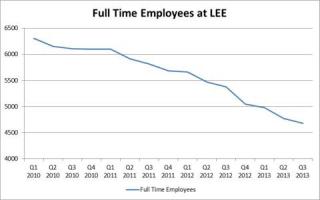
The author recounts how Lee has aggressively fired valuable workers with the obvious intent and certainly the effect of shrinking its papers, at the same time raising prices, all in order to outrun its massive debt. It's a classic death spiral - strangling the business's revenue-producing base in order to sustain itself for a few more days. It might make sense if the goal were to outlive a temporary downturn of fortunes, to survive until a brighter day, but there is not going to be a resurgence in the newspaper business - the entire industry is in a state of irrevocable decline. Peruse the well-informed Newsosaur blog, by no means an anti-newspaper venue, to get a sense of ongoing disaster, recent back-to-back posts including The newspaper crisis, by the numbers, Robots could do better than some journalists, and Are newspapers doomed? It depends.
Earlier this year, Lee reorganized its debt to increase both its term and rate, the latter now 9.25%. This at a time when individuals can get mortgages for 3%! They crow about extending the term to 2022 and pay top executives hundreds of thousands for such astute deal-making, but here's a news flash - business fundamentals in this industry are not going to be improving between now and 2022. The article at the link has good financial information on this company and makes it clear that surviving is nearly an insuperable task for them. As Seeking Alpha put it, "Lee Enterprises has embarked on an unsustainable business model of destroying its product while raising prices in an effort to sustain its financial performance".
The State Journal has suffered from a series of out-of-town publishers appointed by Lee overlords, the latest being John Humenik, who came here from another Lee outlet in Tuscon, Arizona last winter. You see this in many industries (including education), where top leadership cadre are drawn from a small, homogenized, national pool of professionals steeped in industry if not company practices and mores. Alienation from local traditions comes to be seen as almost a virtue - what do these local hicks know anyway? Which is pretty annoying in a town hosting one of the greatest universities in the world and one of its largest and finest libraries, a town where workers' compensation and social security were conceived (not to mention the Onion!). You could be annoyed at the State Journal in the past for sliding into rabid wingnuttery, but couldn't deny their authenticity. That is emphatically no longer the case for this nationalized "local" paper, which understands its own community about as well as it does the new social and media environment (not much).
The University of Wisconsin affects Madison profoundly and provides a sophisticated local audience. We are at or close to the top for book-buying in the country. You're looking for a top expert on (say) Jane Austen - why she lives here! And that's true for hundreds of subjects. You wouldn't know it from the look of the local paper, which tends towards philistinism. I sent them a book review once mentioning Paul Scott, author of The Raj Quartet; they cut the reference, helpfully explaining that readers would just be confused - this was shortly after it got huge exposure as a PBS extravaganza in the 1980s. It was bizarre, people talking about it on the street, and here is a local editor seriously (and not unkindly) giving me pointers on reaching the hoi polloi, himself arguably less informed than his average reader.
Weeks into his new job, Humenik raised the rates and decreed a new subscription model. This is straight from LEE HQ as outlined by Seeking Alpha above, raising the price of home delivery almost exactly 33%, from $22.65 to $29.95 per month. But they give you more - a "full access subscription" to their website! It's comical really, because the key base of older subscribers devoted to the very concept of a daily newspaper does not want or need the online access now being forced on them, while everyone else can invoke the simplest means to defeat their paywall. In raising prices by 4/3, they can sustain a 25% reduction in circulation (3/4 as much), taking in the same revenue and still benefiting from a lower production cost. Far from a side effect, that seems to be the desired outcome - truly burning the furniture, considering that circulation is the foundation not only for ad revenue, but for overall weight in the community.
It will keep them warm for a couple years. State Journal Sunday circulation peaked at ~160,000 in the 1990s, daily circulation ~100,000 in 2008, buoyed by the Capital Times folding in April, 2008 (the other daily paper in Madison until that time). It's been downhill ever since, Sunday circulation declining inexorably at about 5% a year, daily a bit more robust but down. The most recent report in March, 2014 shows Sunday circulation at 104,174, daily at 81,286. So a 25% reduction would take them to 80K / 60K, and I'm guessing that will be quickly reached, the rate increase compounding underlying trends.
Unmoored from their community, the State Journal can miss Wisconsin stories even when noticed by the national media. Such was the case when elements of the Republican Party of Wisconsin came out in favor of the right to secede from the United States earlier this year, a particularly galling episode for someone (me) whose great-grandfather served in Company I of the Eighth Wisconsin Volunteer Infantry in the Civil War, going through hell in combat and a Confederate prison camp in order to save the union and destroy slavery. Check the link above for references - the nub of it is that a local GOP convention was taken over by wingnuts with their fetish for opposing the federal government, as if they were John Calhoun in 1832 or Jeff Davis in 1861 - they passed a resolution asserting the right to secede and nullify federal laws. Dan Bice at the Milwaukee Journal picked it up, Dana Milbank at the Washington Post mocked them, meanwhile nothing but silence from the State Journal.
In the end, the resolution was buried at the state-wide GOP convention, but another one demanding that legislators nullify Obamacare got 145 votes to 303 against. The article at that link is titled "Wisconsin GOP Fights Off Crazy Tea Party Resolutions — Including One Upholding Right To Secede" - the article is from the AP, but was printed and headlined by editors at Business Insider, business-minded people with better news sense than our local newspaper. Editors at the State Journal thought it was a tempest in a teapot, I mean secession and nullification were not passed at the state-wide convention and they were not going to be.
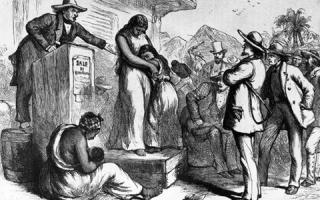
I tried to explain to them that an organization where such notions are seriously entertained in 2014 (passage at a local convention, 1/3 for nullification) is an organization in which radical, out-of-the-mainstream beliefs have significant influence. And that is news, that the party controlling the governorship and both houses of the state legislature and which controls all policy at the state level must cater to such folks, even when understanding the offensive echoes of a slaveholders' rebellion which worked mightily to destroy the republic in order to bolster that revolting institution. The State Journal had something on the story eventually, grudgingly, but great-grandfather John Hidinger might have expected better from the paper down the street from where he drilled at Camp Randall all those years ago (I do).
They don't get it and are not going to. Maybe they think they're sensible centrists navigating between secessionists and equally wild-eyed Democrats who, say, favor collective bargaining rights for public employees. Bullshit, one side is cracked and one is not - that's not just a Madison or Dane County standard, that's a fact, and failing to see it constitutes a special kind of blinkered self-delusion posing as balance.

Yesterday the U. S. Seventh Circuit Appeals Court in Chicago held a hearing on Wisconsin and Indiana's challenged anti-gay marriage laws, it was news all over Wisconsin and appeared on the front pages of most Wisconsin newspapers (the most helpful Newseum has images of newspaper front pages from all over the world every day, including twenty-one from Wisconsin as of this writing - scroll down to Wisconsin and hover over a link to show a thumbnail, click the link to show it at screen size). The La Crosse Tribune ran the AP article above the fold together with a nice picture from the AP with rank-and-file gay lovers - "Hoosiers in Love" and "Love is Love", very nice. Most Wisconsin papers ran the article (or a pointer to it) on the front page with verbs like "blast", "grill", "slam", and "chide". Here is the first sentence from the AP article and more from a little way down:
Federal appeals judges bristled Tuesday at arguments defending gay marriage bans in Indiana and Wisconsin, with one Republican appointee comparing them to now-defunct laws that once outlawed weddings between blacks and whites. ...
Judge Richard Posner, who was appointed by President Ronald Reagan, was dismissive when Wisconsin Assistant Attorney General Timothy Samuelson repeatedly pointed to “tradition” as the underlying justification for barring gay marriage.
“It was tradition to not allow blacks and whites to marry — a tradition that got swept away,” Posner said. Prohibition of same sex marriage, he said, is “a tradition of hate ... and savage discrimination.”
Posner frequently cut off Indiana Solicitor General Thomas Fischer, just moments into his presentation and chided him to answer his questions.
At one point, Posner ran through a list of psychological strains of unmarried same-sex couples, including having to struggle to grasp why their schoolmates’ parents were married and theirs weren’t.
“What horrible stuff,” Posner said. What benefits to society in barring gay marriage, he asked, “outweighs that kind of damage to children?”
Those verbs seem only descriptive of the content and many in Wisconsin and nationally went with the Tribune's "Judges blast Wisconsin, Indiana gay marriage bans", presumably what the AP attached to it, because Googling that headline produces scores of hits from the nation's major news outlets.
All the State Journal had to do was pass through the AP's content and presentation, but oh no, they "improved" it - headline "Judges appear skeptical" accompanied by a large picture of plaintiff's attorneys and a smaller one of the odious Julaine Appling with her attorney (see image at the top). That's slant pure and simple, and it doesn't match the content. That Judge Posner virtually ranted against the defendants representing the states of Wisconsin and Indiana is highly significant. Although appointed by Reagan, this fine jurist is far from characterized by that fact and has interesting thoughts on all kinds of subjects. In this case, he's simply intelligent and compassionate enough to realize what's right and what's going to happen in this country, and soon.
We're in a position in Madison, one of the most gay-friendly locales in the United States, where the local paper is slower than federal judges appointed by Reagan and AP headline-writers to see the lay of the land. You are literally dumber after having been subjected to the State Journal's packaging. Awesome. The heck of it is that they are reasonably good on this subject; it's not malice, but striking ineptitude and tone deafness, a failure to see a big local story or even adequately report it out after being handed over by a national news organization.

Two little case studies, you say, big deal. The problem is that they illustrate all too well what is wrong with this paper, editorially speaking, and cases could be multiplied ad infinitum. There are signs these folks want to reform and better match their community but you have to wonder at this point if they know how. It's like the great Thomas Mann novel Buddenbrooks, where the second generation in a highly successful business family faced radically different conditions and oscillated wildly between conservative and innovative responses, failing at them all. They were going down no matter what they did (subtitle: The Decline of a Family). Many fine people work at the State Journal, skilled and industrious just like in 1977 when the bums at MNI and Lee Enterprises broke their unions. They had no pity then, they did not care, and there's no reason we should when the hard hand of destiny strikes them down.
Mike Bertrand
Madison, Wisconsin
August 28, 2014
Update (8/30/2014): The U. S. Securities and Exchange Commission publishes 10-K forms many corporations file with them, and they can contain good information. Proceed as follows to get Lee's 10-K's. First go to the SEC site, then choose Filings > Company Filings Search from the menu along the top. On the next screen, enter LEE in the Fast Search box (default text "Ticker or CIK"), then click Search. The next screen should say "LEE ENTERPRISES, INC CIK#: 0000058361" and have a list of documents. In the Filter Results section towards the top, enter 10-K for Filing Type and check include for Ownership, then click Search. That should show a list of the annual 10-Ks since 1994. As of this date, the top item is the 10-K filed 2013-12-13 - click the Documents button for that line towards the left and on the next screen click the htm file linked on the first row, the one for the 10-K. Voilà, you should see Lee Enterprises's Form 10-K for the fiscal year ended September 29, 2013 (150 pages printed out!).
Scroll down just a bit and click the link to the right of Item 6, Selected Financial Data - this link sends you directly to the 2013 10-K's selected financial data and this is what you should see:

The figures in this chart are in thousands of dollars, so the operating revenue for 2013, for example, was $674,740,000 - 674 million dollars. The trends mentioned in the body of the article are on grim display, operating revenue almost down to the level it was before Pulitzer was devoured. Revenue was over a billion in 2008, so at least the rate of decline has eased up (see the selected financial data for 2004-2008 in the 2008 10-K). Lee hasn't had a profit (net income) since 2010 and debt servicing decimates operating income, even when the latter is in the black, which it wasn't in 2013, 2011, and 2009.
The State Journal has an unusual relationship with Lee Enterprises as explained in their 2013 10-K; note that "MNI" is Madison Newspapers, Inc. (text-search the 10-K for Madison to find references - Ctrl+F in Chrome):
We own 50% of the capital stock of MNI and 17% of the nonvoting common stock of The Capital Times Company (“TCT”). TCT owns the remaining 50% of the capital stock of MNI. MNI publishes daily and Sunday newspapers, and other publications in Madison, Wisconsin, and other Wisconsin locations, and supports their related digital products. MNI conducts business under the trade name Capital Newspapers. ... Net income or loss of MNI (after income taxes) is allocated equally to the Company and TCT.
The "other publications" mentioned include the Beaver Dam Daily Citizen (circulation 7,735), the Portage Daily Register (3,955), and the Baraboo News Republic (3,414). Evidently they are the only MNI paid circulation newspapers other than the State Journal, at least they're the only ones mentioned in the 10-K. The Capital Newspapers site mentions a number of other publications, including the now free weekly Capital Times in Madison and what are presumably free newspapers and shoppers covering Sauk and Dodge and other surrounding counties.
MNI financials have been broken out in Lee's 10-Ks since 1998 - search the phrase Investments in Associated Companies and pass over the Tuscon section in recent forms to see sections like this from 2013:
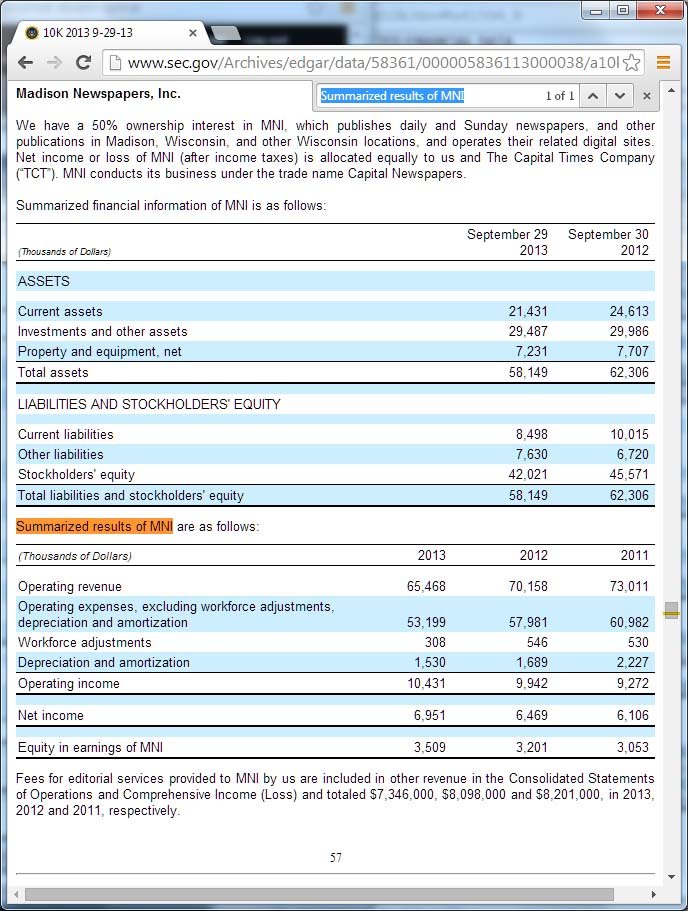
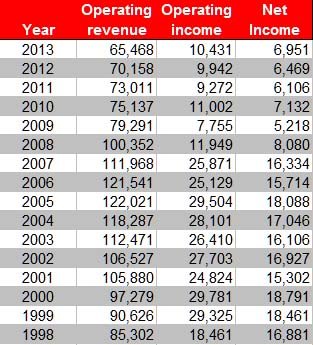
Here are the MNI financials since 1998 from Lee's 10-Ks - I checked every three years since each report has the two previous years (unlike the 10-Ks, I put each year in a row rather than column). A number of things jump out, particularly the peak in 2005. And look at that big drop in income from 2007 to 2008, never recovered from. Remember that the Capital Times folded as a daily in April, 2008 and the 2008 numbers were reported out later that fall. Presumably that was the precipitating event, not just the loss of business, but whatever payouts and rearrangements they executed at the time. Maybe killing the Cap Times wasn't such a hot idea after all. Also the calamitous decline in profit margin over the years (Net income / Operating Revenue), ~20% in the late 1990s and now under 10% most years. Revenue is down badly, but it is the income decline that is most striking, now about one third of peak values only eight years ago. MNI revenue is suspiciously close to 10% of Lee revenue in recent years, you have to think that is a target for both organizations. It underscores the importance of the State Journal in the Lee empire, vying with a couple others for second place to the mighty St. Louis Post-Dispatch.
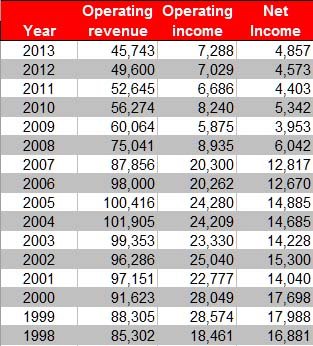
The chart above actually minimizes the extent of the debacle, because the raw data is in current dollars before being normalized for inflation. The idea is that if inflation is 10% from time t1 to time t2 (for example), then it takes $1.10 at t2 to buy what $1.00 bought at t1. Dividing by 1.10, it takes $1.00 at t2 to buy what $1.00 / 1.10 = 90.9¢ bought at t1. In other words, a simple fraction involving the rate of inflation over the period is multiplied by t2 dollars to make them equivalent to t1 dollars in buying power. The U. S. Bureau of Labor Statistics gives us a simple but authoritative numerical series called the Consumer Price Index (CPI) for every month since 1913, so it is simply a matter of some spreadsheet work to adjust the table above by the appropriate fractions to express all amounts in 1998 dollars - I used the September CPI for every year from 1998 to 2013. The trends are accentuated, with notable stability between 2001 and 2006, a slight downturn in revenue in 2007, then the cliff at 2008, and operating revenue cratering since then. Factor in that real U. S. GDP has grown by about 35% between 1998 and 2013 to understand how epic is the economic failure.
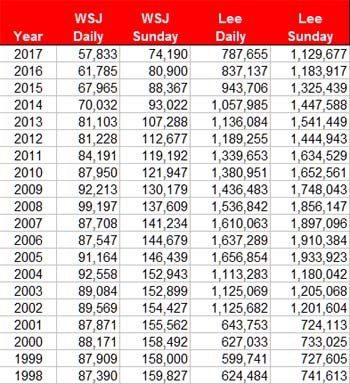
Here is the circulation for the Wisconsin State Journal and Lee Enterprises from Lee's 10-Ks. The big jumps in Lee's circulation in 2002 and 2005 are due to their acquiring the Howard group (fifteen dailies) and Pulitzer, respectively. The Lee chain was painstaking built up over the years since its founding in 1890, for decades a sleepy though no doubt effective little group with under twenty papers, the State Journal their flagship. Then they decided to go big in the new century (their third!). What a monumental mistake, perfect though it is as a negative example - a malignant guardian angel couldn't have timed it worse. In 1998, the State Journal was over 20% of Lee's Sunday circulation, now it is a third of that with all the acquisitions, the Post Dispatch in particular. The State Journal has lost Sunday readers throughout the period, gradually at first, then at an accelerating pace starting in 2005, down an average of 4% per year since then and down an average of 5% per year since 2008. Daily is holding up better. Notice the spike of over 11K in 2008 (99,197 in 2008 over 87,708 in 2007). That is due to converting Cap Times subscribers, but they sloughed off quickly and daily circulation has declined by 4% per year, on average, since 2008. Dane County increased in population from 420,000 in 1998 to 503,000 in 2012, about 20%, so these numbers understate the State Journal's decline in penetration in its market area.
[Update (12/13/2014):The orderly retreat has turned into a rout, see the 2014 circulation figures in the updated chart above. I predicted 80K / 60K soon, down from 104K / 81K in March 2014, and half of that was achieved between March and September of 2014, both daily and Sunday down over 13% compared to 2013, September to September. Dan Simmons put the best face on things a few days ago headlining The Wisconsin State Journal and Madison: A 'trusted relationship' for 175 years (link). The 'trusted relationship' is from a fellow who publishes the paper and probably lives in Arizona. The 1977 strike was mentioned in their pages perhaps for the first time since 1977, something both papers "suffered through". Joe McCarthy is mentioned, but not the paper's shameful role in promoting him. It almost reads like an obituary, no need to speak ill of the dead, and you do wonder how long this can go on. The damnable thing about it is that there have been people in the organization over the years who understood the dynamics and acted accordingly, including the capable Frank Denton, mentioned as someone who tried to reorient the paper during his tenure as editor from 1986 to 2004. Not so coincidentally, Denton has Madison roots. His efforts to repair the rupture between paper and community were undone by egregious successors, as arrogant as they were reactionary, notably publishers James Hopson (2000 - 2006) and Bill Johnston (2006 - 2013). The damage is done — there won't be another 175 years, maybe not another five.]
The State Journal is owned by Madison Newspapers, Inc. (MNI), dba Capital Newspapers. As mentioned above, Lee owns half of MNI and The Capital Times Company (TCT) owns the other half, with profits distributed equally between the two. Since Lee in turn owns 17% of TCT, the TCT share of profits is less than half - 41.5% doing a linear calculation. We know who Lee is, but who is The Capital Times Company? They are owners of the Capital Times, once the co-equal of the State Journal, who published a liberal daily in Madison between 1917 and 2008. They fell on hard times as so many afternoon papers did and were killed by MNI in 2008, except for a rump presence online and as a free weekly. The Cap Times was founded, owned and run for years by William T. Evjue, a progressive who fought the State Journal politically as well as for market share for decades, their mutual production pact notwithstanding. Then:
When he [Evjue] died in 1970, the will he wrote directed that all the proceeds from the controlling voting stock that he owned in The Capital Times Co. be turned over to the Foundation that he had formed a few years before.
Evjue's will called for 32,539 shares of class A common stock to go to the William T. Evjue Charitable Trust and 32,539 shares of class B common stock to go to the William T. Evjue Family Trust. Class A is voting stock, class B not. As far as I can tell, the two classes of stock have equal value, and these two blocks constitute all the stock of the Capital Times Company, apart from that held by Lee. The purpose of the charitable trust is to pass on incoming revenue to the William T. Evjue Foundation for further distribution to worthy groups; the purpose of the family trust is to pass on revenue to a number of Evjue's relatives - his and his wife's nieces and nephews and their descendants (he had no children). So the Capital Times Company is owned by those two trusts and Lee (17%) and here is how MNI's profits are distributed:
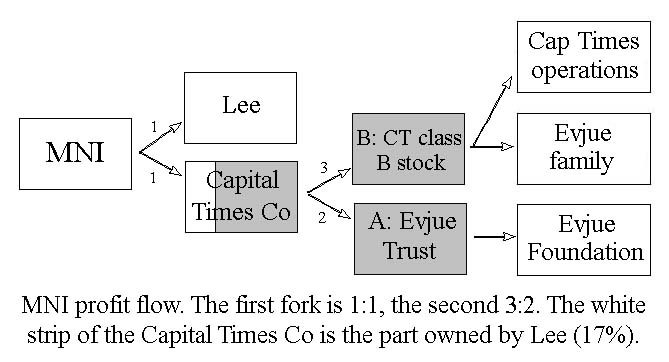
Charitable trusts and foundations have to file Form 990s with the IRS containing their financials and other information. The Evjue Charitable Trust's 990s are available here, the Evjue Foundation's here. Evjue's will expressly requires that:
All of the net income of this trust [Evjue Charitable Trust] shall be distributed at least annually to the Evjue Foundation, Inc. to carry on it's religious, charitable or educational activities.
Indeed the 990s show that the outgoing grants from the trust have closely matched the incoming grants to the foundation the last few years (I checked 2009-2012). In 2012, for example, the first was $1,300,118, the second $1,282,119.
In his will, Evjue gave the trustees explicit permission to sell the class A (voting) Capital Times shares, but only if they agreed to do so unanimously. The next sentence of the will is:
I express the wish that no sale of the shares of the Class A Stock of the Capital Times Company be made unless required to prevent substantial wasting of the trust estate by reason of the inability of the Capital Times Company to operate successfully.
Records in the Dane County Probate Office show that is exactly what they did at some point. Recent reports from the trusts on file there show that the charitable trust holds 20,966 class A shares of the Capital Times Company of the 32,539 shares they were bequeathed, while the family trust still holds 31,539 class B shares of the Capital Times Company of the 32,539 they were bequeathed. It looks like Lee's 17% stake in the Capital Times Company consists of the 11,573 = 32,539 - 20,966 shares of class A stock sold them by the charitable trust. Long story short, Lee owns 17% of the Capital Times Company stock and apparently 34% of the voting stock.

If all correct so far, Capital Times Company stock is distributed roughly in the ratio 1 : 2 : 3 between Lee, the Evjue Charitable Trust, and the Evjue Family Trust and therefore MNI profits are distributed in the ratio 7 : 2 : 3 among these organizations, considering that MNI ownership is split 50-50 between Lee and the Capital Times Company. This reconciles well when comparing Evjue Charitable Trust income to MNI profit over recent years (using Part I, line 4 of the the 990-PFs for the trust, which is dividends and interest from securities).
The Capital Times' business is deteriorating in direct proportion to that of MNI, considering that the profit share from MNI appears to be their only significant source of income (the dearth of ads in the weekly paper is cringe-worthy). Based on the foregoing, about 25% of MNI profits go to the holders of class B stock not marked for the charitable trust. Applying 25% to MNI's 2013 profits of $7 million results in $1.75 million for operations and dividends to the family. That's not much considering that the Cap Times continues to pretend they are a real news organization, spending significantly for professional salaries and newsprint. Not much and, to repeat, on a downward trend.
The Evjue Charitable Trust is not wasting away. They hold large assets for what's supposed to be a pass-through organization. Their 2012 Form 990-PF shows $30,0153,699 in total assets (Part II, line 16(c)); granted, almost $8 million of it is the value attached to the Capital Times stock, but that still leaves $22 million in assets, none of which has been passed through to the foundation in recent years. Maybe they need it to adequately compensate their trustees, who each got $36,000 in 2012 for one or two hours of work per week according to the 990-PF. Most of these folks also got $12,000 in 2012 from the foundation, for what I'm guessing was not a bone-crushing amount of work.
The Evjue Foundation also holds considerable assets, almost $18 million in early 2013 according to their 2012 Form 990-PF (Part I, line 20), so the trust and foundation are sitting on top of about $40 million. The IRS has a 5% minimum annual payout requirement for such charitable organizations if they are to be tax exempt, including stiff penalties in case of violation. Maybe the 5% rule doesn't apply to one or both of these groups, but it stands as a reasonable government-sanctioned standard for minimum disbursements for charitable organizations. The idea is that the purpose of such organizations, and the reason the government encourages them through the tax code, is to get money into the hands of worthy recipients, not to hoard a nest egg. 5% of $40 million is $2 million which, added to the $1 million a year or so passed through from MNI, suggests a reasonable annual giving target of about $3 million, more than double the $1,325,599 average given out 2009-2014 (2014 grants total $1,074,012 so far).
It appears the trustees of the Evjue Charitable Trust owned all the voting stock of the Capital Times Company after Evjue's death and now own something under two thirds of it, having sold the rest to Lee. If that's correct, the trustees control about 28% of MNI and the Wisconsin State Journal (2/3 x 5/12 = 10/36 = 27.8%). The exact percentage is a bit of a mystery, Lee claiming in the statement above that the stock they hold in the Capital Times Company is nonvoting. Perhaps the trustees in fact control very little, or perhaps they are venal sellouts - the relative proportion is hard to determine from outside. What is certain is that, together with Lee, the owners of the Capital Times set out to cause a strike in 1977 and broke their unions; also that they acceded to the destruction of the Cap Times as a viable operation in 2008. It's hard to imagine Evjue agreeing to either. He monomaniacally promoted the Cap Times, his beloved lifetime project. He was a devoted Madisonian with no love lost for menacing out-of-town newspaper chains or industrial combinations generally, all in keeping with long-held Progressive principles. In his memoirs he wrote proudly that the Cap Times had never been struck, that he gladly signed the third Newspaper Guild contract in the country in 1934 and the first city-wide one. The trustees of the Evjue Charitable Trust since 2003 have been John Lussier and Nancy Gage, Evjue relatives; Clayton Frink, publisher of the Capital Times; Dave Zweifel, editor emeritus of of the Capital Times; and Brady Williamson, a prominent Madison attorney. What an exquisite irony that Bill Evjue's blood, political, and business heirs daily enable their old patron's sworn enemy, at the same time sapping it's life blood and diverting it to the community at large.

